Arizona Birds-Top 12 Arizona Birds. This section is the Species Accounts. These are designed to help you to recognize birds you see in your backyard. I have used eBird to select the most common birds common common common commoncommon. “Common” means the birds seen were seen often throughout the year, not necessarily the most numerous.
Each species account starts with an image. I have tried to us Personalhotographs of each species if I have them. But I’ve done my bird photography mostly in the West. Thus, I’ve had to rely on others for pictures of some common Eastern birds. I always make sure the bird images (mine and others) are correctly identified.
Arizona Birds Identification And Pictures
In the identification section, I am using size and shape,e, and bill type before considering the color or patterns of the birds. I find these more reliable when trying to identify an unknown bird. Pay attention to the body and tail shape and especiathe lly bill shape of birds you see, not just plumage color.
I have written an article on How To Identify Birds, it is slightly different from other popular identification methods. Check it out if you wish: 7 Steps To Identify Birds.
In the section on Bird Feeders And Foods, I tell how to attract each species. Not all types of backyard birds will come to feeders. But all backyard birds can be attracted to water. So don’t forget to add a birdbath to your bird feeding station.
Do you live in Northern Arizona? Southern Arizona? Central Arizona? The Sonoran Desert? Southeastern Arizona? Southwestern Arizona? To appear in this article, most birds are widely distributed throughout the state and are often year-round residents. However, for those birds that are more localized in place or time, I list the General Region And Seasonality. Please see the section following these species accounts for the lists of common species by season.
Even if a species is found in a general area, they occur only in the Habitat They Prefer. So, the exact habitat of your neighborhood is important for the presence or absence of certain kinds of birds.
Mourning Dove
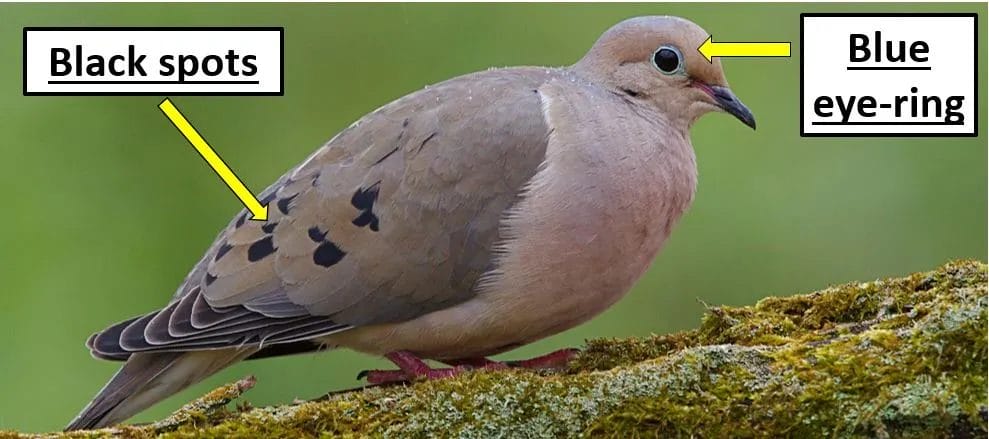
Arizona Birds
- Mourning Doves are the most widespread and most frequent backyard bird in the Lower 48 states of the United States.
- Range In Arizona: Mourning Doves Are Year-Round Residents Rhroughout Arizona.
- Identification: This is a Key Species for comparing with an unknown bird.
- Size: About 12 inches long from bill tip to tail tip. About the same size as Northern Flicker. Larger than American Robin. Slightly smaller than the han domestic city pigeon.
- Shape: Very plump with a small round head. The tail is long and pointed. Legs are short.
- Bill: Small and rather slender.
- Color: Pale brown-pink body, darker wings, and tail. White edges on side of the tail.
- Habitat, Range & Behavior: Semi-open areas such as urban areas, farmlands, and woods.
- It is a resident across the lower-48 states and Mexico, with some movement out of northern areas in winter.
- Often seen perched on wires and fences. Their mournful cooing is a familiar spring birdsong.
- Food and feeder preference: Mourning Doves eat seeds almost exclusively. Attract with black oil sunflower seeds on a large sturdy tray feeder or the ground.
House Finch
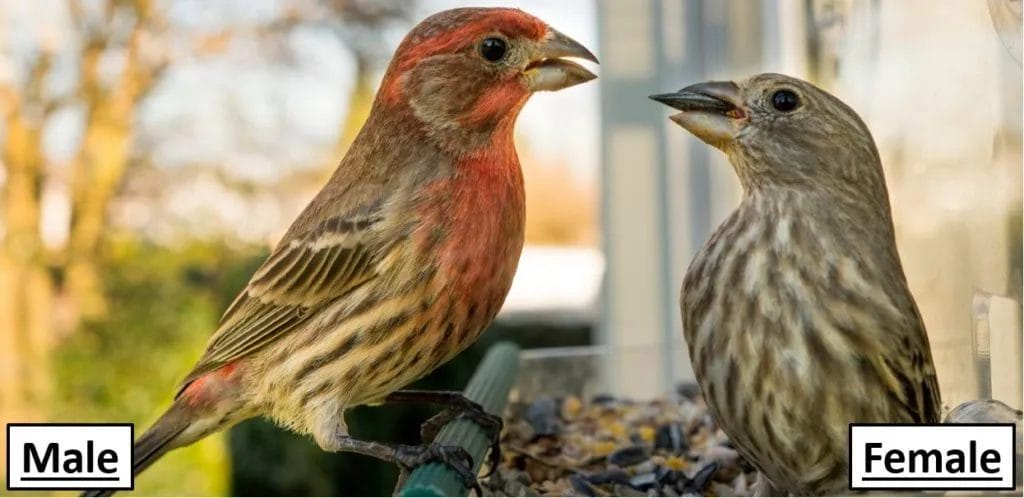
Arizona Birds
Originally a bird of the West, now commonly found across most of the US. There are other red finches, but these are the ones most likely in residential areas.
- Range in Arizona: House Finches are year-round residents throughout Arizona.
- Identification: This is a key species for comparing with an unknown bird.
- Size: About 6 inches from bill tip to tail tip. Larger than goldfinches and chickadees. Smaller than a White-crowned Sparrow or Spotted/Eastern towhees.
- Shape: Medium build with a medium-long notched tail. Round head.
- Bill: Short, conical.
- Color: Brown and gray above with streaks on the sides of the pale underparts. Males with red (sometimes orange or rarely yellow) crown, chest, rump.
- Habitat, range & behavior: You’ll find small flocks on wires, in short treetops, and in bushes. Originally deserts and grasslands. Rural areas and towns are where they’re now most common.
Formerly found in the western United States and Mexico. Then introduced into the northeastern United States, but now found in nearly all of the lower-48 states and extreme southern Canada. Rare in plains states (Dakotas to Texas) and southern Florida.
- House Finches are not territorial, but males sing throughout the year–a lively, wiry song ending in a couple of buzzy notes.
- Food and feeder preference: They love sunflower seeds and tube feeders. May eat from thistle socks.
Gila Woodpecker
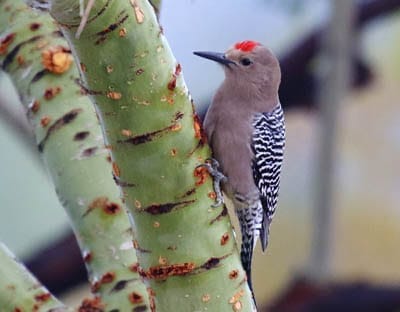
Arizona Birds
Range in Arizona: Gila Woodpeckers are year-round residents across southern and southwestern Arizona in the Sonoran Desert.
Identification:
- Size: Larger than a Starling. Smaller than an American Robin.
- Shape: Stout bird with Lara ge head. Short tail.
- Bill: Long. Chisel-shaped.
- Color: Tan body. Black-and-white striped back and wings. White wing patches show in flight. Red crown of male lacking an n female.
- Habitat, range & behavior: A bird of saguaro deserts. Also found in larger trees along desert streams. Has adaptedlivinglive in towns and residential are a range
- range from Arizona south into western Mexico.
- Probes and gleans for food from the bark. Does not generally excavate for food as many other woodpeckers do. Excavates nest hole in saguaro cactus.
- Food and feeder preference: Insects, als,o fruits, and berries. May drink a from hummingbird feed will likely feed on suet.
Lesser Goldfinch
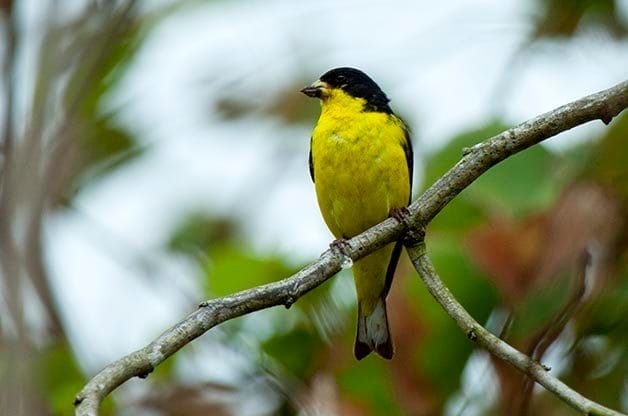
Arizona Birds
This bird replaces American Goldfinch in the backyard in drier parts of the southwestern US.
Range in Arizona: Lesser Goldfinches are year-round residents in most of Arizona–western, southern, and central Arizona, summer residents only in northeastern Arizona.
Identification:
- Size: A small bird. Slightly smaller than American Goldfinch, but close.
- Shape: Big head, neckless, short forked tail.
- Bill: Short, small, conical.
- ColGreenbackback, yellow underparts including under tail coverts. Black wings and tail with white marks. The Male was an ith a black cap on his forecrown. Keeps the same bright yellow plumage year-round, unlike American Goldfinch.
- Habitat, range & behavior: Open scrubby woodlands of oak or other trees, field ds, grasslands.
- Found in the western and southwestern US, into the Great Basin in summer. Found southward to Middle America.
- They sometimes gather into flocks of hundreds to feed in weedy fields.
- Food and feeder preference: They eat mostlythistle andd seeds and some insects. At your feeder, they will eat black oil sunflower seeds at a tube feeder but prefer Nyjer seeds in a “thistle sock” feeder.
Verdin

Arizona Birds
This relative of the chickadee is common in desert habitats in the SW United States.
Range in Arizona: Verdins are year-round residents in central, southwestern, and southern Arizona.
Identification:
- Size: Very small. Just a bit smaller than a chickadee.
- Shape: Plump with a medium-lengthngth rounded tail.
- Bill: Short. Straight. Stout.
- Color: All gray with a yellow face.
- Habitat, range & behavior: Found in desert scrub and thorny shrubs.
- California to Texas and south into northern Mexico.
- Forages actively on limbs and tips of vegetation in the manner of a chickadee.
- Food and feeder preference: They eat primarily insects off of shrubbery. They are not attracted to seed feeders nor have they been documented to drink fresh water! They may drink sugar water from oriole nectar feeders.
Anna’s Hummingbird
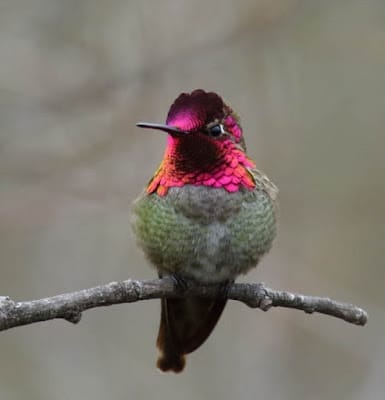
baby bird identification Arizona
This big resident hummingbird is common in the far West everywhere there are people!
Range in Arizona: Anna’s Hummingbirds are year-round residents in western, central, and southwestern Arizowith na, winter visitors only in southeastern Arizona.
Identification:
- Size: Slightly larger than widespread hummingbirds like Ruby-throated in the east and Rufous Hummingbird in the west. Smaller than a goldfinch or chickadee.
- Shape: Plump, with long wings covering the ing tail. Unmistakable long bill.
- Bill: Longer ththethe han head, round, slightly downcurved.
- Color: Grupperpartsarts, grunderpartsrts wthe ith greenish cast on sides. Male with entire head and throat covered in iridescent metallic rose pink. Female usually has pink throat spot.
- Habitat, range & behavior: Chaparral, open woodland ds, and suburban gardens all host this species.
- Formerly only in northern Baja and southern Califo,rnia they expanded to Arizona, way to southern Alaska along the Pacific coast, following planting winter-bloomingming flowers, and the popularity of placing out hummingbird feeders.
- Nest early (December to February), even as they move north and encounter snow in winter.
- Food and feeder preference: Nectar and small insects is their main food. Both are available in flowering plants. Quickly find hummingbird feeders filled with sugar water.
Arizona Birds-Top 12 Arizona Birds
White-crowned Sparrow
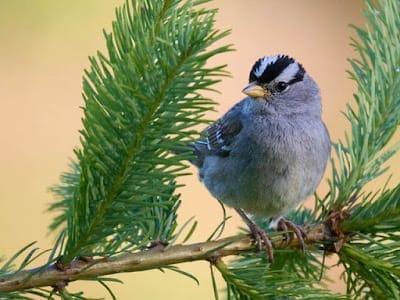
best bird feeders Arizonazona
Range in Arizona: White-crowned Sparrows are winter visitors throughout Arizona, year-round residents in a small area of north-central Arizona.
- Identification: This is a key species for comparing with an unknown bird.
- Size: About 7 inches. A large sparrow the ear size of Spotted/Eastern towhee. Larger than House Finch. Smaller than Starling or Red-winged Blackbird.
- Shape: Longer plump body, round head, long tail.
- Bill: Short and conical.
- Color: Brownback, wings, tail, gunderpartsarts, black-and-white striped crown. For their first-year immature birds have tan and reddish-brown striped crowns.
- Habitat, range & behavior: Open and shrubby areas.
- Coastal form in California is the edge of dunes. Common winter form in California breeds on Arctic tundra. Various forms breed across the Arctic Canada and Alaska and in mountains in western Canada and the United States.
- They sing in spring migration as they move northward. Different populations have slightly different songs.
- Food and feeder preference: Weed seeds, grain, insects. Eat black oil sunflower seeds and other seeds on hopper and tray feeders.
Yellow-rumped Warbler
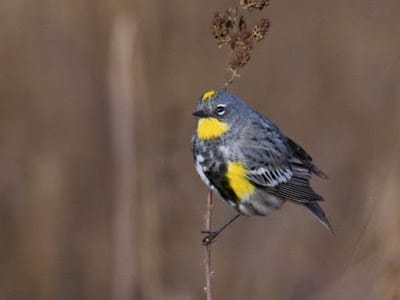
Arizona Birds
An abundant winter visitor in the southern US to treetops and weedy areas.
Range in Arizona: Yellow-rumped Warblers are year-round residents in southeastern Arizona, summer residents in northeastern Arizona, and winter visitors only in western Arizona.
Identification:
- Size: Small, they are a bit larger than chickadees and goldfinches. They are smaller than House Finches and juncos.
- Shape: Plump and neckless with a shorter tail.
- Bill: Short, slender, straight, pointed.
- Color: Breeding plumage in spring is blue-gray on the upper parts, black s, ides and chest, yellowandd mp, yellow on sides. Two forms: western form was ith yellow throat and large white wing patch; eastern and northern form with white throat and two white wing bars. In winter plumage both forms are gray-brown abound, pale cream below. Yellow rump and white tail corners in flight.
- Habitat, range & behavior: In breeding season mostly in coniferous or mixed forests, in mountains, in the west. In winter open areas with fruiting shrubs and scattered trees.
- Breed across Canada and Alaska and in conifer forests in the west. Winter along both coasts and the southern states through Middle America.
- There are also non-migratory forms in Mexico and Guatemala. They tend to forage in outer branches about halfway up the tree.
- Food and feeder preference: Mainly insects in the summer, they switch to waxy berries and fruit in winter. They are thus able to winter farther north than other warblers. They are attracted to suet feeders. Arizona Birds-Top 12 Arizona Birds
Arizona Birds-Top 12 Arizona Birds
White-winged Dove
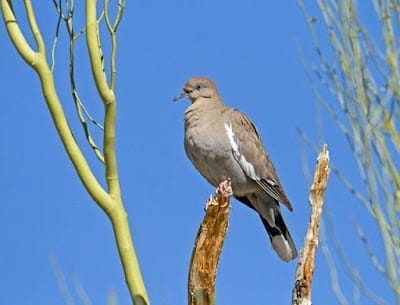
Arizona Birds
Range: White-winged Doves are summer residents in southwestern and southeastern Arizona na, and year-round residents in south-central Arizona.
Identification:
- Size: A bit larger than a Mourning Dove.
- Shape: A more muscular neck than Mourning Dove. A square tail.
- Bill: Short and slender.
- Color: Brown with black in the der tail base and broad white tip. White wing patches in figure ht, are also visible when perched.
- Habitat, range & behavior: Desert thickets, saguaro c, actions, and towns.
- Found in the southwestern United States, MidAmericaican, and West Indies.
- They often seek water in the morning and afternoon.
- Food and feeder preference: They eat seeds, grain, and fruit of the saguaro cactus. They are more likely to feed on a raised platform feeder than on the ground. They will eat black oil sunflower seeds and cracked corn.
Curve-billed Thrasher
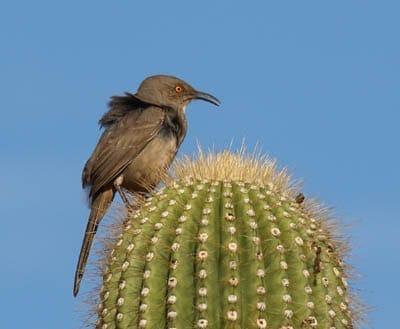
bird cage Ariza widespread
A widespread desert bird that is commonly found in backyards in the Southwest.
Range in Arizona: Curve-billed Thrashers are year-round residents in southwestern and southern Arizona.
Identification:
- Size: A larger bird. Longer than an American Robin, slightly shorter than a Mourning Dove.
- Shape: Rather long and thin was ith a short neck and ample tail.
- Bill: Slender, fairly long, slightly curved.
- leather ather dusky brown throughout. More easterly populations have punderpartsarts with dark spotting. Western populations are more uniform brown. Pale orangish eye.
- Habitat, range & behaviThis especially ally favors cholla cactus and is found in residential areas where this cactus is present.
- Widespread in the desert Southwest, both the Sonoran Desert of Arizona the and Chihuahuan Desert of West Texas. Also, from Colorado south through Mexico.
- Feeds mostly on the ground underneath desert shrubs and cacti. Runs from bush to bush across open ground.
- Food and feeder preference: Omnivore, eats invertebrates, berries, and fruits from cactus. They will visit backyard bird feeders. They may eat seeds but enjoy suet and mealworms. They also take advantage of birdbaths.
Gambel’s Quail

Arizona Birds
A desert bird that may visit backyards on the edge of town.
Range in Arizona: Gambel’s Quail are year-round residents in western, south-central, and southern Arizona.
Identification:
- SiOnlyonly as long as an American Robin. Shorta er, a bill to tail, than Mourning Dove, though much differently shaped.
- Shape: Round and plump with strbreastseast and legs. Relatively small head. Short tail.
- Bill: Short, stout. Cu island de iscurved.
- Color: Blue-gray chest. Cream belly was an ith dark central patch. Back and tail brownish. Rusty streaked flanks. Chestnut crown. Two ornamental feathers drooping the ver forehead.
- Habitat, range & behavior: Found in brushy and thorny desert scrub.
- Ranges deserters from Colorado south to west Texas and California into NW Mexico.
- Forage on the ground in flocks. Run from danger.
- Food and feeder preference: Nearly all plants ants: seeds, leaving es, berries. Mesquite tree pods are a favorite food. They may visit a low platform feeder or seed scattered on the ground. They will eat sunflowers, millet, cracked corn, and are one of a few birds that will eat milo–a common filler seed in cheap birdseed. Will come to water on the ground.
Great-tailed Grackle

Arizona Birds
Big, noisy bis and often found near water and in urban landscapes.
Range in Arizona: Great-tailed Grackles are year-round residents throughout Arizona.
Identification:
- Size: Large bird. Maare les about the size of a crow; female les smaller but still as large as a Mourning Dove.
- Shape: Long and slender with a big full tail.
- Bill: Long, pointed, stout.
- Color: Glossy black with purplish highlights. Females browner.
- Habitat, range & behavior: Shorelines, golf courses, agricultural areas, urban centers.
- Found in southern portions of West and Midwest US south through Central America.
- Forage on the ground. Social and loud, with squeaky calls and whistles.
- Food and feeder preference: Omnivorous–insects, fruits, human food scraps. To keep these obnoxious birds away from your feeders never feed birds human food wastes.
Read More Article: Blue Birds in Michigan
Read More Article: Why Do Birds Suddenly Appear?
Read More Article: How Do Birds Mate-Everything Explained
Read More Article: Bird Flying
Read More Article: Tropical Birds- Top 8 Tropical Birds
Read More Article: CAN DOGS EAT BREAD








